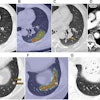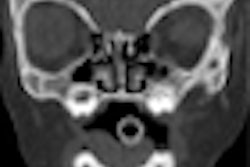While there are many individual steps that can be taken to reduce CT radiation dose, a comprehensive, hospital-wide dose reduction program provides the most benefit, according to an article published in the October issue of the American Journal of Roentgenology.
Thanks to its multifaceted approach to CT dose management, William Beaumont Hospital was able to take steps to reduce unnecessary CT studies, adjust scanning parameters to lower dose, reduce organ-specific radiation dose, and ensure proper implementation of procedures and new protocols via a quality control effort.
"While small-scale efforts (i.e., only decreasing tube current or only adjusting voltage) are a good start, dose reduction that translates into patient safety cannot be achieved without addressing the many factors that can contribute to lifetime increased exposure," lead author Dr. Elias Antypas, PhD, told AuntMinnie.com. "This is why we chose to address all such aspects comprehensively."
With the goal of addressing CT radiation dose reduction, the hospital in 2010 formed a committee that included four radiologists, two physicists, a radiation safety officer, two CT technologist supervisors, a computer specialist, the radiology clinical manager, and the hospital administrative director (AJR, October 2011, Vol. 197:4, pp. 935-940).
To achieve their goals, the committee's basic plan was to focus on avoiding unnecessary CT exams, limit studies to the anatomy of interest in order to decrease scanning length, minimize the number of phases, and review every inpatient CT order. They also wanted to employ limited follow-up CT protocols, adopt a high pitch for CT angiography (CTA) protocols, alter tube current and voltage, utilize breast and thyroid shielding, and implement dose modulation software, according to the authors.
To tackle the problem of unnecessary CT exams, the committee used a CT log book to identify the number of repeat CT studies. Referring physicians and CT technologists were then informed of the repeat order using the institution's Epic health information system (Epic Systems).
Over the next few months, the committee also reviewed plans for multiphase protocols and studied tube voltage and tube current parameters via a literature review. Board-certified medical physicists also performed CT radiation dose and quality control trials using phantoms; a trial of 40 to 60 cases was performed in which one parameter was changed in each trial, and quality was reviewed and approved by radiologists, according to the authors.
The committee also adopted a plan for physician education and monthly in-service teaching to CT technologists. CT protocol and quality control monthly conferences were held for radiology residents and fellows.
"Progress was monitored through various individual meetings as well as with input from consulting radiologists and information technology members until changes were put into practice successfully," the authors wrote.
Avoiding unnecessary studies
Using the CT log book placed at each of the institution's CT scanners, technologists tracked and recorded repeated studies. Similar data were collected for repeat studies performed within two months of each other. Data were collected for 90 days, and on the basis of this information, new policies and modified low-dose protocols were established, the authors wrote.
In addition, the committee determined that all CT exams ordered within 30 days of each other would require approval by radiologists. Technologists were also trained to recognize unnecessary or repeat orders, and inform radiologists of any repeat request that involved radiation to the same body part, according to the authors.
Thanks to the hospital's IT department, an automatic alert is now made to the ordering physician and to the CT technologist on the Epic system whenever a duplicate or repeat CT is ordered. Clinicians can use a dedicated quality assurance pager number to consult with a radiologist if they have any questions; this system has improved communication between the referring physician and the radiologist and helped to determine if the repeat study is justified, according to the authors.
"For example, if a referring clinician requests a spine CT and the patient had a recent CT of the chest, abdomen, and pelvis, rather than undergo an unnecessary repeat study of the same area, the spine can be reconstructed from the existing data," they wrote.
And CT is not always the most suitable imaging modality to answer a clinical question, according to the authors.
"Having such a system in place allows attending physicians and resident and fellow radiologists to function as consultants, offering alternative modalities that do not involve radiation or offering limited CT examinations when possible," they wrote.
New protocols
From the phantom tests, the medical physicists concluded that a reduction in tube voltage from 120 to 100 kVp for a routine chest CT would reduce radiation dose by approximately 40% on its dual-source 128-detector-row CT scanner, 38% on its 64-slice scanner, and 28% on its 16-slice scanner.
"On average, our data indicate that when tube voltage is decreased to 100 kVp in patients with a [body mass index (BMI)] < 30, the result is approximately 35% dose reduction," they wrote.
Radiation dose reduction was also achieved using tube current modulation software (Care Dose, Siemens Healthcare). Phantom testing showed that a 10% dose reduction could be achieved by lowering reference mAs from 200 to 180 for chest CT and 240 to 220 for abdomen and pelvic CT studies.
"Thus, for a patient undergoing a routine chest CT at 100 kVp and reference mAs of 180, the overall radiation dose is reduced by approximately 50%," the authors wrote. "Although there was some increase in noise with the decrease in kVp, the increase was minimal with the decrease in reference mAs."
Efforts were made to also to keep scanning length to only the area of interest. A high pitch (2.4 in flash scanning mode) was also able to further reduce dose on the dual-source scanner in chest, abdomen, and pelvis studies.
To achieve organ-specific dose reductions, the hospital utilized Siemens' X-Care dose reduction software. Based on phantom testing, the committee also discovered that bismuth breast shields could reduce dose by 24% to 32%. As a result, breast shields have been implemented on all female chest CT studies, the authors reported. Thyroid shields have also been adopted for all patients undergoing chest CT exams.
Antypas credited a multidisciplinary approach and teamwork for the success of the dose reduction program.
"Whether it be the attentive CT technicians, the CT clerks who kept log books, the IT staff who created alerts for ordering physicians or repeat scans, our physicists who performed dose reduction studies, or the direct involvement and supervision of our radiologists, it was clear that a culture was put in place that is attentive and responsive to dose reduction and patient safety," he said.
When asked what advice he would give to other institutions contemplating a hospital-wide dose reduction program, Antypas emphasized that it's important to have radiologists and physicists involved to effectively realize dose reduction without compromising image quality.
"We found it beneficial to have a quality control program dedicated to CT radiation that serves to review and update CT protocols as well as to ensure the proper implementation of procedures," he said. "Lastly, it is essential that CT technologists are familiarized with the strategies outlined by the American College of Radiology regarding minimizing radiation exposure."





















